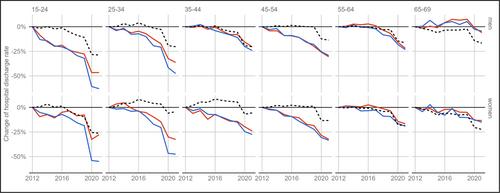Alcohol-Specific Inpatient Diagnoses in Germany: A Retrospective Cross-Sectional Analysis of Primary and Secondary Diagnoses from 2012 to 2021
Abstract
Aims
Our study aimed to a) describe the distribution of hospital discharges with primary and secondary alcohol-specific diagnoses by sex and age group, and b) describe how the number of hospital discharges with primary and secondary alcohol-specific diagnoses have changed across different diagnostic groups (categorized by primary International Classification of Diseases, 10th Revision [ICD-10] diagnosis) over time.
Design
Retrospective cross-sectional analysis.
Setting
German hospital settings between 2012 and 2021.
Participants
All persons aged 15–69 admitted to hospitals as registered in a nationwide data set.
Measurements
We counted a) the number of all hospital discharges and b) the number of hospital discharges with at least one alcohol-specific secondary diagnosis (secondary alcohol-specific diagnosis) by year, sex, age group, and diagnostic group. One diagnostic group included all primary alcohol-specific diagnoses, while 13 additional groups aligned with ICD-10 chapters (e.g., neoplasms). Alcohol-involvement was defined as either a primary or secondary alcohol-specific diagnosis.
Findings
Of 95 417 204 recorded hospital discharges between 2012 and 2021, 3 828 917 discharges (4.0%; 2 913 903 men (6.4%); 915 014 women (1.8%)) involved either a primary or at least one secondary diagnosis related to alcohol. Of all alcohol-involved hospital discharges, 56.8% (1 654 736 discharges) had no primary but only a secondary alcohol-specific diagnosis. Secondary alcohol-specific diagnoses were particularly prevalent in hospital discharges due to injuries. With rising age, alcohol-involvement in hospital discharges due to digestive or cardiovascular diseases increased. Between 2012 and 2021, the rate of alcohol-involved hospital discharges has decreased more in younger as compared with older adults (average change between 2012 and 2021: 15–24: −55%; 25–34: −41%; 35–44: −23%; 45–54: −31%; 55–64: −21%; 65–69: −8%).
Conclusions
The number of alcohol-involved hospital discharges in Germany from 2012 to 2021 more than doubles (from 1 654 736 to 3 828 917) when including secondary alcohol-specific diagnoses. More pronounced declines among younger adults may be attributed to unequal changes in alcohol consumption patterns across the population and to the hazardous effects of long-term alcohol use.


 求助内容:
求助内容: 应助结果提醒方式:
应助结果提醒方式:


